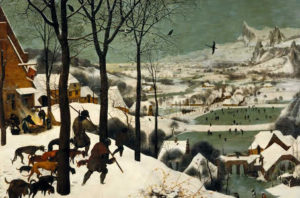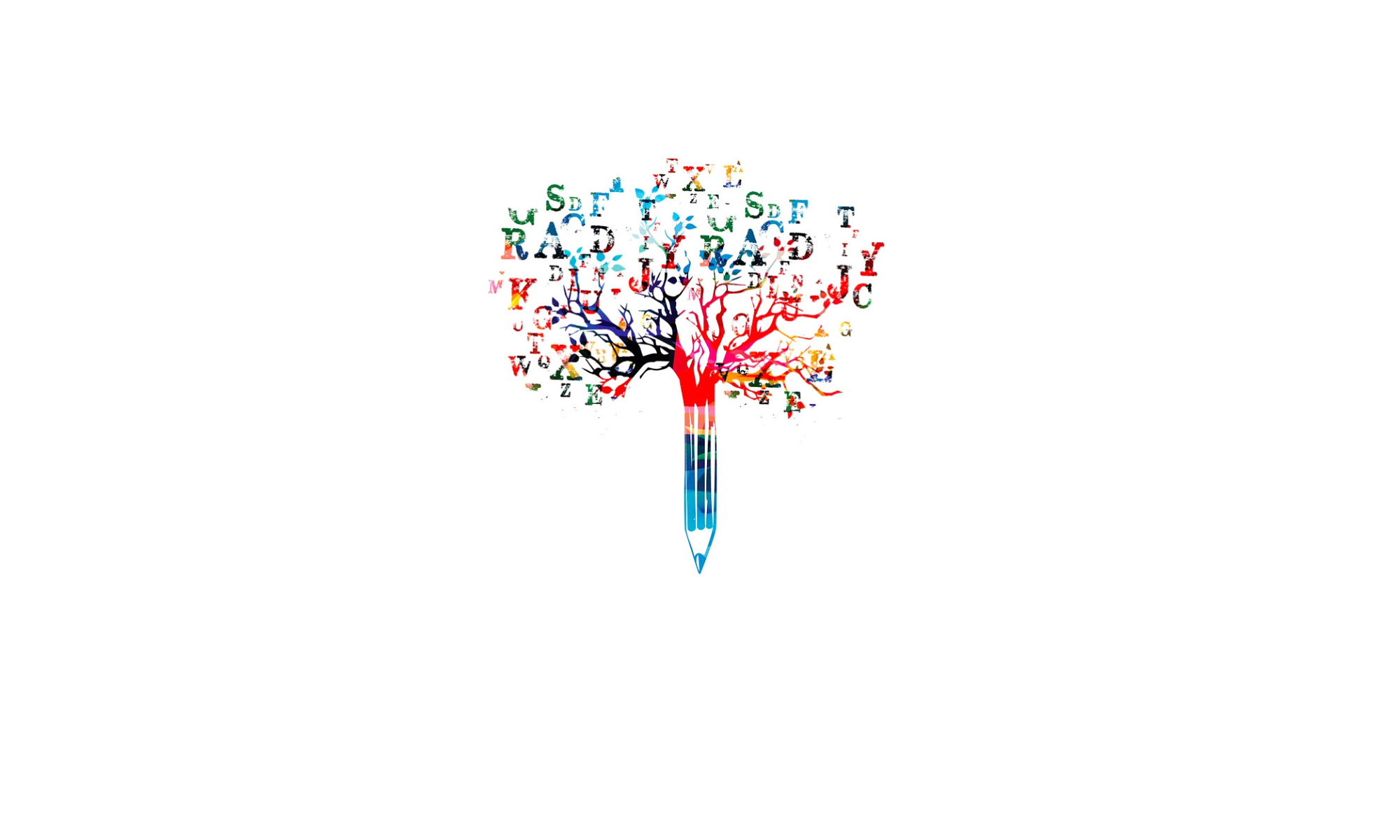What inspires an ekphrastic poem? This question, posed in relation to Keats’ Ode on a Grecian Urn (see comments), led me to think about particular paintings, such as Breughel’s Hunters in the Snow, and their unique ability to inspire so many creative responses.
The subject-matter of the painting itself – a ‘peopled’ winter landscape – has proven attractive to many artists and writers. I have discovered an excellent, short article on inspiration derived from winter scenes that you may enjoy reading before going further: “A Mind of Winter” by Charlie Fox, published in Cabinet Magazine, Issue 59, 2015. http://www.cabinetmagazine.org/issues/59/fox.phpartic2
Brueghel’s Hunters in the Snow has not only inspired poets, but has been used in a variety of other media as well. It’s interesting to know that even film directors have included the painting in their scenes as a way of moving the narrative. Some examples are: Andrei Tarkovsky’s films Solaris (1972) and The Mirror (1974), Lars von Trier’s 2011 film ‘Melancholia,’ Alain Tanner’s film ‘Dans la ville blanche’ (1983) and inspired Roy Andersson’s 2014 film ‘A Pigeon Sat on a Branch Reflecting on Existence’. (more information can be found on:
http://www.theartsdesk.com/visual-arts/yuletide-scenes-5-hunters-snow)
As far as poetry goes, Williams’ is, of course, not the only poet to be inspired by Brueghel’s Hunters in the Snow. Below are four poems that eloquently engage with this painting, yet differ in their representation of the subject matter and technique employed by Brueghel.
Now it’s your turn: After reading and enjoying these poems, consider each in the context of their ekphrastic approach to Brueghel’s painting. To help you get started, try using Kranz’s categories as explained in Perspectives I* . Think about perspective, as discussed in relationship to Williams’ ‘Hunters in the Snow’ . On the other hand, Is the poem focussed more on the narrative behind the painting than its composition? Or does the poet employ a whole variety of ways to translate the painting to the poem?
[*To refresh your memory, see “Terms” at the end of this blog entry, below).
This is where the fun begins! Please send your comments. I’m very interested in hearing your take on these wonderful ekphrastic poems.
The Hunters in the Snow: January
Joseph Stanton
Time must pass,
even in this frame.
Evening must wait upon us,
and our stillness must be
a moving toward it.
Everywhere we look light lowers.
The evening bird is on the wing
and must be winging somewhere –
falling, falling in soft diagonals.
Though stalked by darkness,
we must reach the vague, vast valley,
and we must sleep.
[From Imaginary Museum: Poems on Art, (Time Being Books, 1999). Re-printed here by permission of the poet.]

Brueghels’ Winter
Rutger Kopland
Winter by Brueghel, the hill with hunters
Almost home, but their dead-tired attitudes, their steps
in the snow – a return, but almost as
slow as arrest. At their feet the depths
grow and grow, become wider and further,
until the landscape vanishes into a landscape
that must be there, is there, but only
as a longing is there.
Ahead of them a jet-black bird dives down. Is it mockery
of this laboured attempt to return to the life
down there: the children skating on the pond,
the farms with women waiting and cattle?
An arrow underway, and it laughs at its target.
[Translated by James Brockway: Memories of the Unknown, (Harvell Press), 2001.]

Winter Landscape
John Berryman
The three men coming down the winter hill
In brown, with tall poles and a pack of hounds
At heel, through the arrangement of the trees,
Past the five figures at the burning straw,
Returning cold and silent to their town,
Returning to the drifted snow, the rink
Lively with children, to the older men,
The long companions they can never reach,
The blue light, men with ladders, by the church
The sledge and shadow in the twilit street,
Are not aware that in the sandy time
To come, the evil waste of history
Outstretched, they will be seen upon the brow
Of that same hill: when all their company
Will have been irrecoverably lost,
These men, this particular three in brown
Witnessed by birds will keep the scene and say
By their configuration with the trees,
The small bridge, the red houses and the fire,
What place, what time, what morning occasion
Sent them into the wood, a pack of hounds
At heel and the tall poles upon their shoulders,
Thence to return as now we see them and
Ankle-deep in snow down the winter hill
Descend, while three birds watch and the fourth flies.
[ From The Dispossessed, (William Sloan, 1948)]
Hunters in the Snow: Breughel
Joseph Langland
Quail and rabbit hunters with tawny hounds,
Shadowless, out of late afternoon
Trudge toward the neutral evening of indeterminate
form
Done with their blood-annunciated day
Public dogs and all the passionless mongrels
Through deep snow
Trail their deliberate masters
Descending from the upper village home in lovering
light.
Sooty lamps
Glow in the stone-carved kitchens.
This is the fabulous hour of shape and form
When Flemish children are gray-black-olive
And green-dark-brown
Scattered and skating informal figures
On the mill ice pond.
Moving in stillness
A hunched dame struggles with her bundled sticks,
Letting her evening’s comfort cudgel her
While she, like jug or wheel, like a wagon cart
Walked by lazy oxen along the old snowlanes,
Creeps and crunches down the dusky street.
High in the fire-red dooryard
Half unhitched the sign of the Inn
Hangs in wind
Tipped to the pitch of the roof.
Near it anonymous parents and peasant girl,
Living like proverbs carved in the alehouse walls,
Gather the country evening into their arms
And lean to the glowing flames.
Now in the dimming distance fades
The other village; across the valley
Imperturbable Flemish cliffs and crags
Vaguely advance, close in, loom
Lost in nearness. Now
The night-black raven perched in branching boughs
Opens its early wing and slipping out
Above the gray-green valley
Weaves a net of slumber over the snow-capped homes.
And now the church, and then the walls and roofs
Of all the little houses are become
Close kin to shadow with small lantern eyes.
And now the bird of evening
With shadows streaming down from its gliding
wings
Circles the neighboring hills
Of Hertogenbosch, Brabant.
Darkness stalks the hunters,
Slowly sliding down,
Falling in beating rings and soft diagonals.
Lodged in the vague vast valley,
The village sleeps.
[New Mexico Quarterly, 1951]
Terms:
* Kranz’s ekphrastic categories:
1. Rhetorical:
a. The figure in the picture addresses the viewer.
b. The figures in the picture or the viewers of the picture address each other.
c. The poet addresses the viewer/viewers.
d. The poet address a figure or figures in the painting, the painting itself, or the painter.
2. Descriptive: the picture is described in some way.
3. Meditative: the picture inspires reflection on the part of the poet.
4. Associative: the picture is associated with a personal experience of the poet.
*Saccadic movement: the way the eye moves over an object both laterally and horizontally.
*Vergence: the adjustment that the eye makes for depth.




